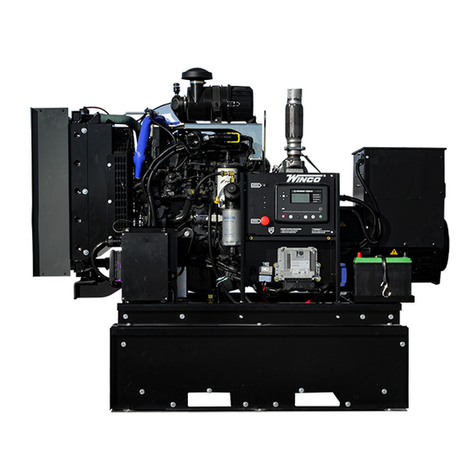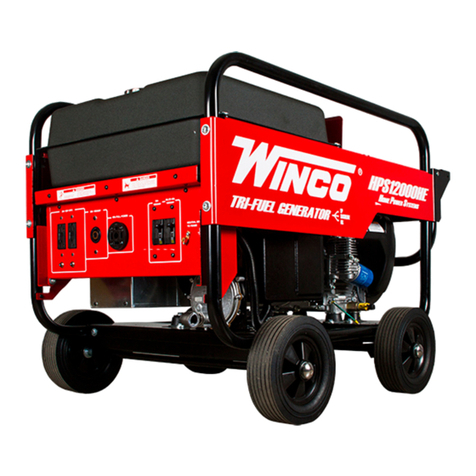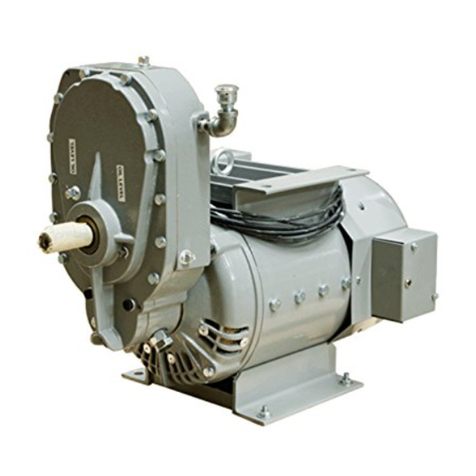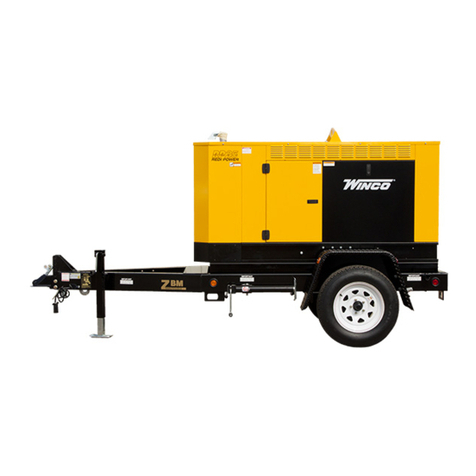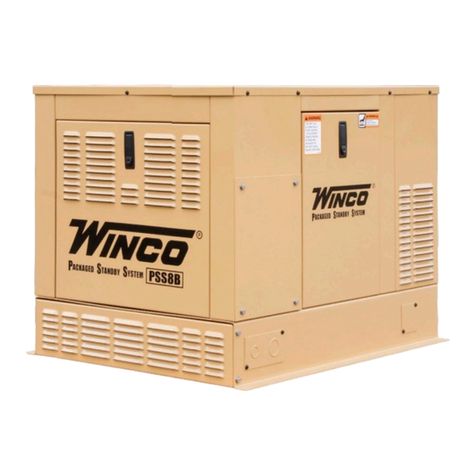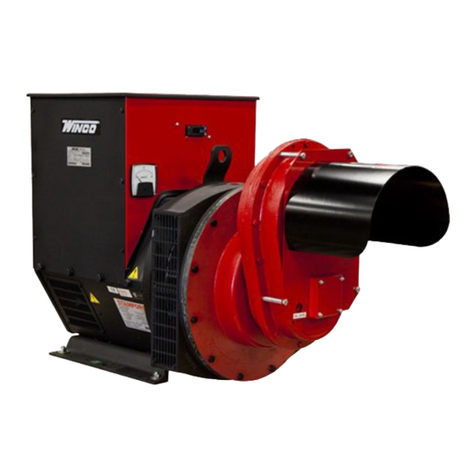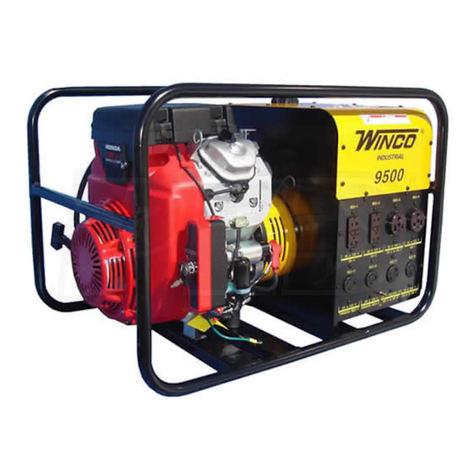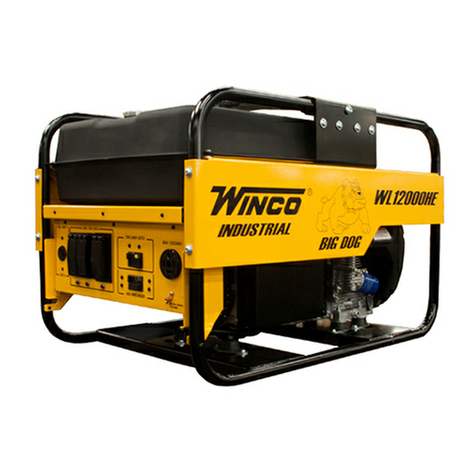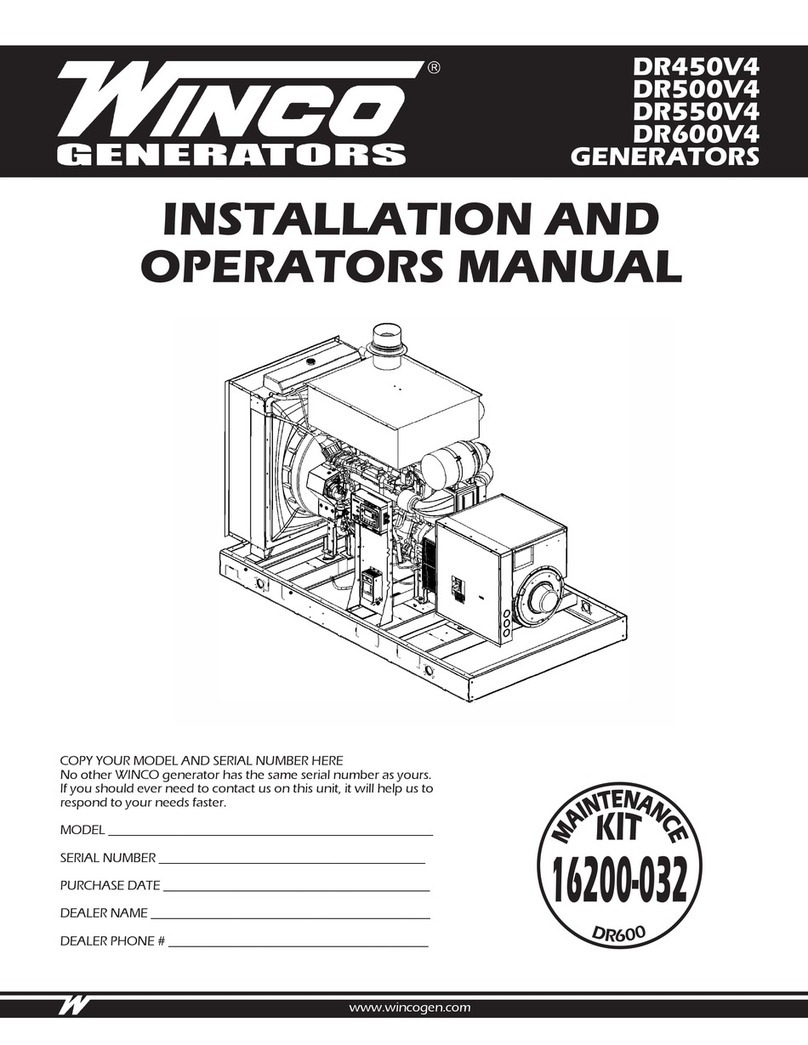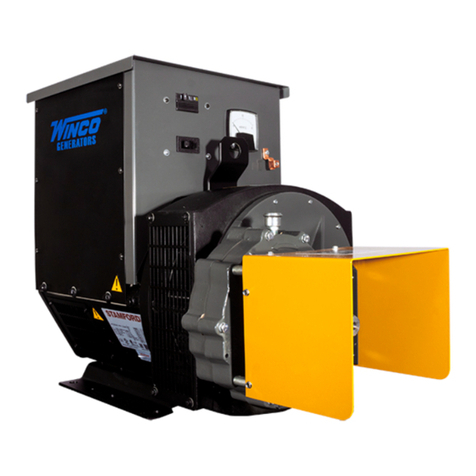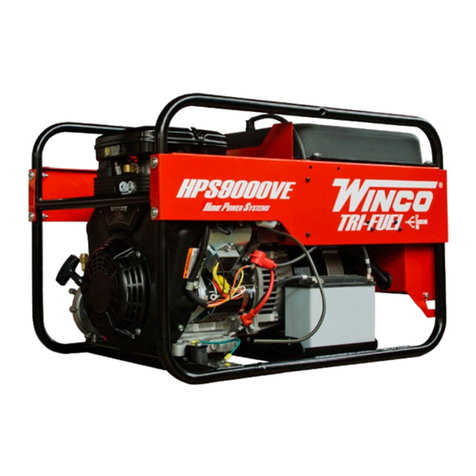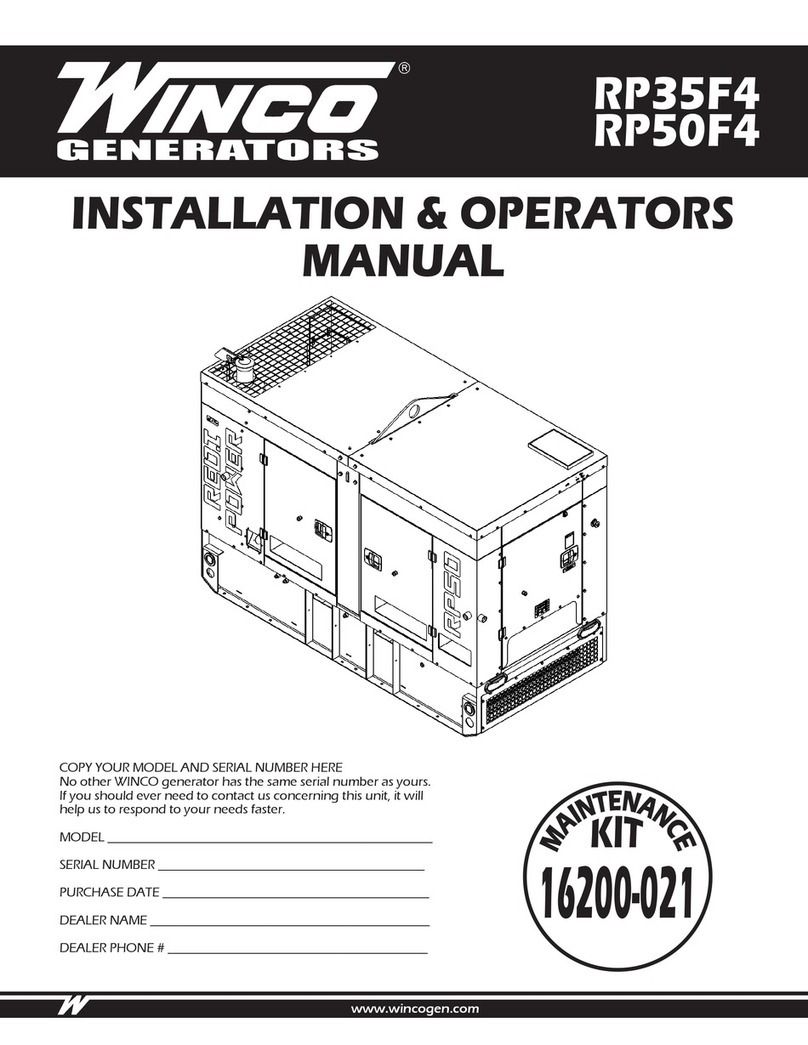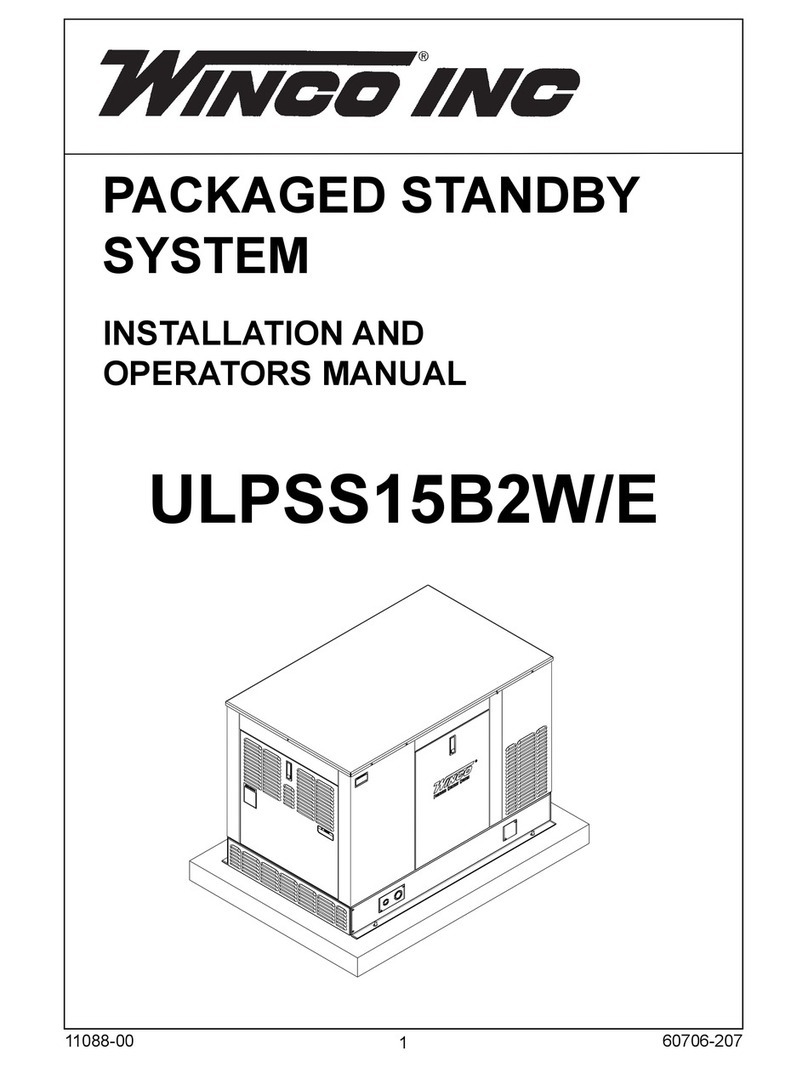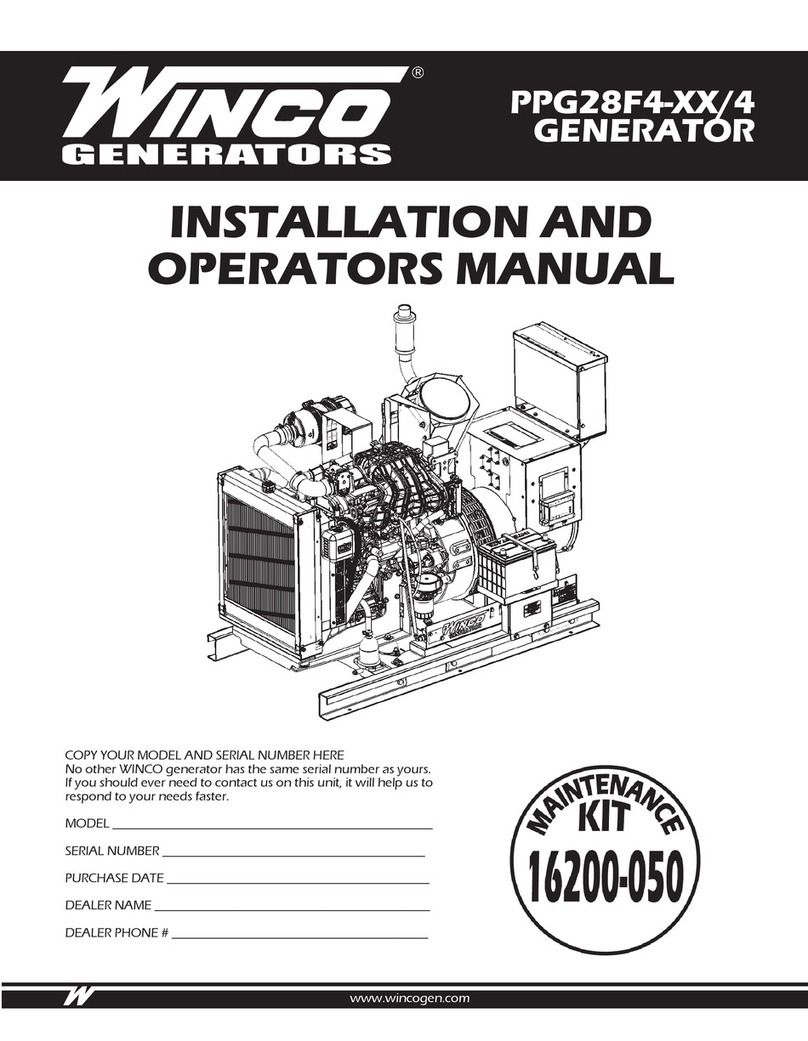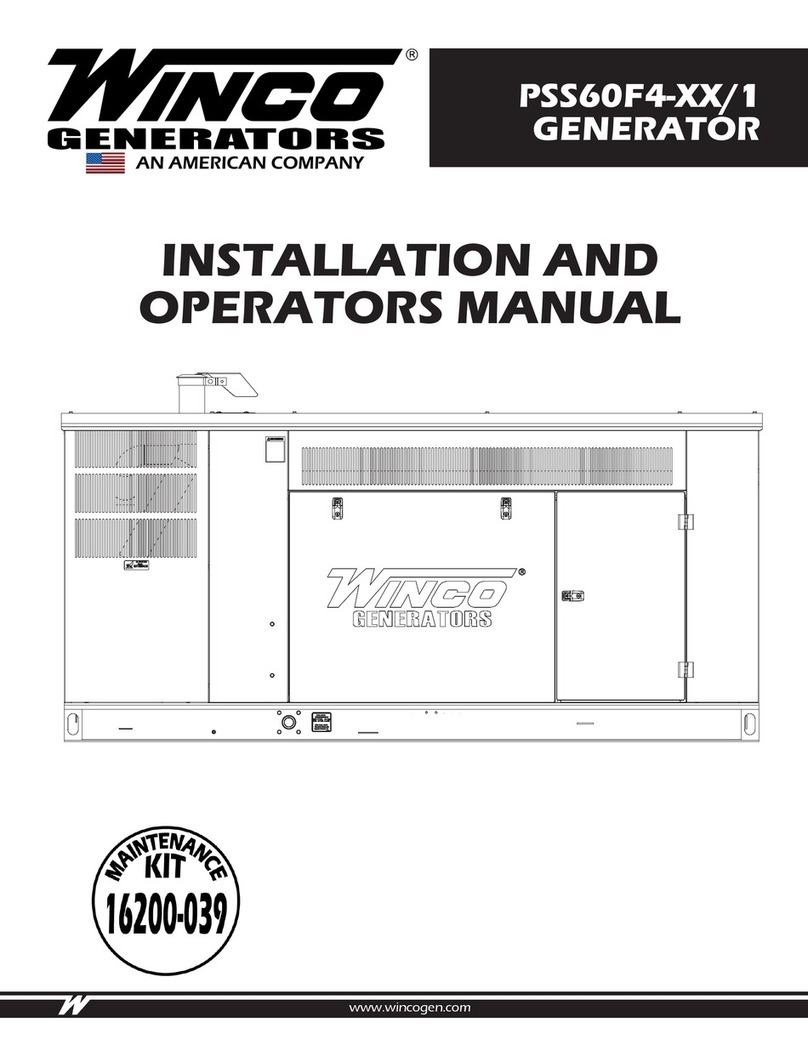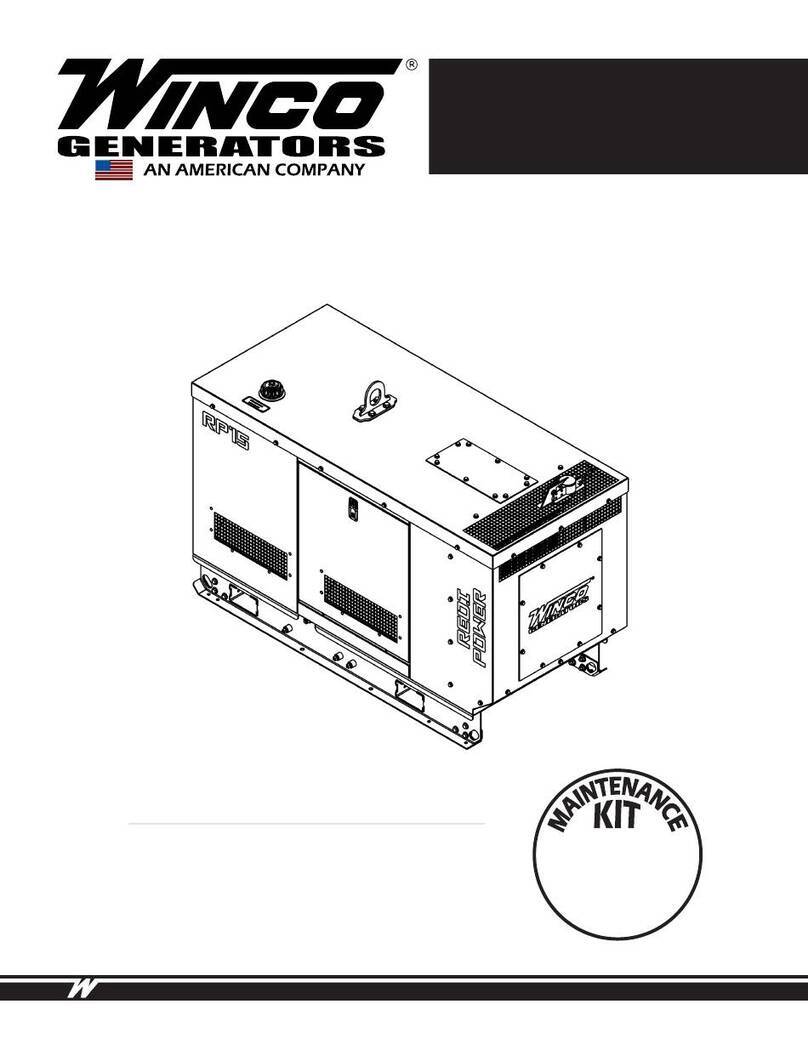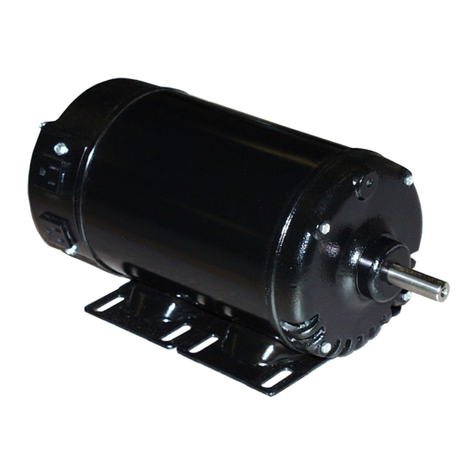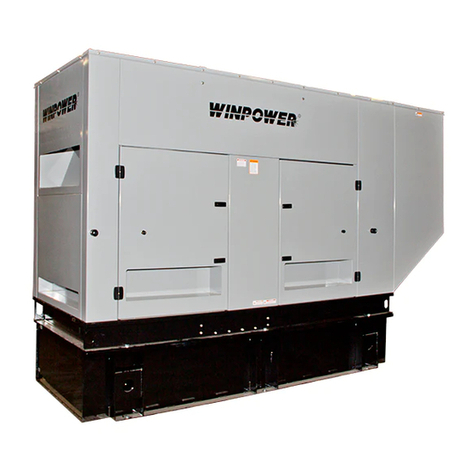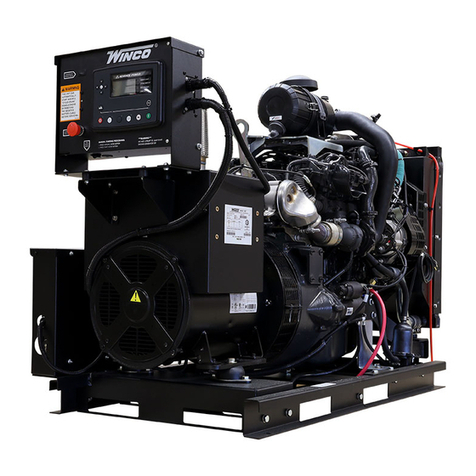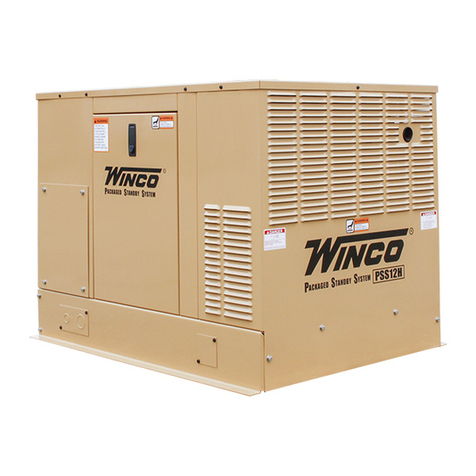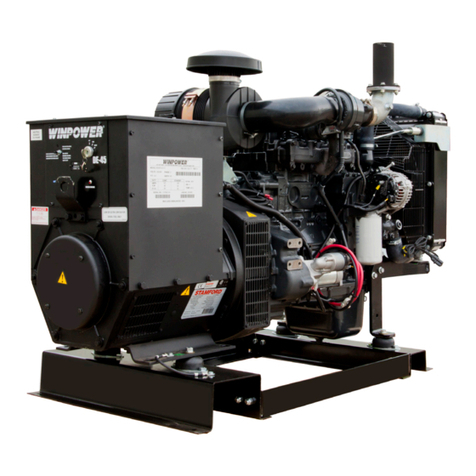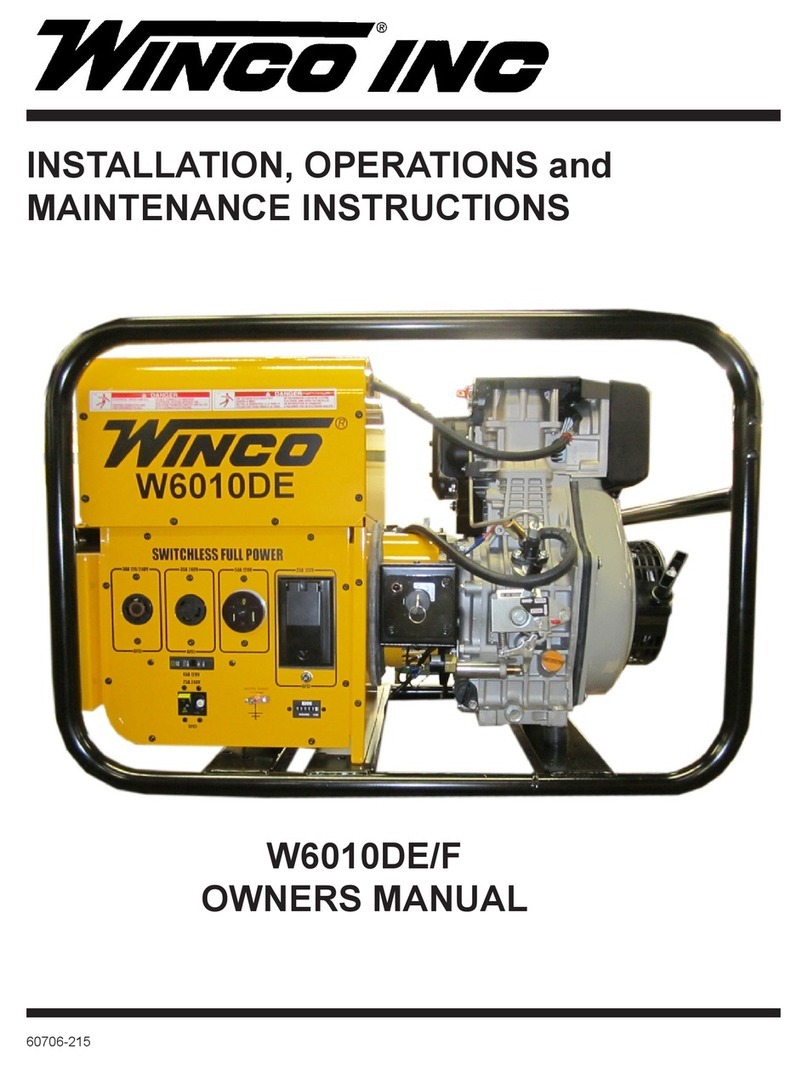
760706-236/E
LP VAPOR
Reference numbers 1,2, and 3 in the previous diagram are
system parts supplied by the customer. Reference number 4
is the engine-generator set. The following table is of the fuel
pressure reading at each reference in the system.
Single Regulator (LP only)
Reference numbers 1, 2, and 3 in the previous diagram are
system parts supplied by the customer. Reference number 4
is the engine-generator set. The following table is of the fuel
pressure reading at each reference in the system.
Two (2) Regulator System (LP only)
7
13240-11 60706-236
The fuel line used to connect the supply line to the
GHPDQGUHJXODWRUPXVWEHDORFDOO\DSSURYHGÀH[LEOH
fuel line. Products used will vary in different regions
depending on availability and local codes. Consult
with your local fuel supplier to ensure complete com-
pliance with ALL codes.
1. Remove the plastic cover plug from the demand
regulator.
&RQQHFWWKHÀH[IXHOOLQHWRWKHGHPDQGUHJXODWRU
or the optional fuel solenoid..
DANGER: PERSONAL INJURY
Do not use galvanized pipe in the fuel line runs.
The galvanized coating will become eroded and
ÀDNHRIIFDXVLQJSRVVLEOHREVWUXFWLRQRUGDPDJH
to the regulator or fuel valve. The obstruction could
cause an inoperative engine or an explosive fuel
leak.
Size of pipe required for generators operating on
natural gas/LP gas.
Length of Fuel Line* Fuel Line Size
less than 25 feet 3/4 inch black pipe
25 to 100 feet 1 inch black pipe
over 100 feet not recommended**
*allow an additional 3 feet for each standard elbow.
Do not use ‘street ells’ (restrictive)
** Consult factory for fuel runs over 100 feet.
DANGER! - FIRE - PERSONAL INJURY -
Be careful when sealing gas joints. Excessive
sealing compound can be drawn into the solenoid,
regulator or carburetor causing an engine malfunc-
tion or dangerous fuel leak.
FUEL CONSUMPTION (Full Load)
Gasoline 1.67 Gal/HR
LP Vapor 2.2 Gal/HR 200,932 BTU/HR
Natural Gas 200 cu ft/hr 200,000 BTU/HR
FUEL PRESSURE
Correct fuel pressure cannot be stressed enough.
The most common cause for inoperative systems is
an inadequate or incorrect fuel pressure. Power and
performance of the engine is in direct relation to the
correctness of the fuel system. Shown below is a
diagram of a typical L.P. or N.G. installation.
Reference numbers 1 through 3 in the diagrams
above are system parts supplied by customer.
Reference number 4 is the engine generator set.
Below is a table of the fuel pressure reading at each
reference in the system.
Fuel Pressure Table
Single Regulator (L.P. Vapor only)
1 34
UNIT OFF TANKPSI 7-11 in 7-11 in
4-6 oz 4-6 oz
STARTING TANK PSI 7-11 in 7-11 in
4-6 oz 4-6 oz
NO LOAD TANK PSI 7-11 in 7-11 in
4-6 oz 4-6 oz
FULL LOAD TANK PSI 7-11 in 7-11 in
4-6 oz 4-6 oz
Two (2) Regulator System (L.P. Vapor only)
12 34
UNIT OFF TANK PSI 10-15 lbs 7-11 in 7-11 in
4-6 oz 4-6 oz
STARTING TANK PSI 10-15 lbs 7-11 in 7-11 in
4-6 oz 4-6 oz
NO LOAD TANK PSI 10-15 lbs 7-11 in 7-11 in
4-6 oz 4-6 oz
FULL LOAD TANK PSI 10-15 lbs 7-11 in 7-11 in
4-6 oz 4-6 oz
7
13240-11 60706-236
The fuel line used to connect the supply line to the
GHPDQGUHJXODWRUPXVWEHDORFDOO\DSSURYHGÀH[LEOH
fuel line. Products used will vary in different regions
depending on availability and local codes. Consult
with your local fuel supplier to ensure complete com-
pliance with ALL codes.
1. Remove the plastic cover plug from the demand
regulator.
&RQQHFWWKHÀH[IXHOOLQHWRWKHGHPDQGUHJXODWRU
or the optional fuel solenoid..
DANGER: PERSONAL INJURY
Do not use galvanized pipe in the fuel line runs.
The galvanized coating will become eroded and
ÀDNHRIIFDXVLQJSRVVLEOHREVWUXFWLRQRUGDPDJH
to the regulator or fuel valve. The obstruction could
cause an inoperative engine or an explosive fuel
leak.
Size of pipe required for generators operating on
natural gas/LP gas.
Length of Fuel Line* Fuel Line Size
less than 25 feet 3/4 inch black pipe
25 to 100 feet 1 inch black pipe
over 100 feet not recommended**
*allow an additional 3 feet for each standard elbow.
Do not use ‘street ells’ (restrictive)
** Consult factory for fuel runs over 100 feet.
DANGER! - FIRE - PERSONAL INJURY -
Be careful when sealing gas joints. Excessive
sealing compound can be drawn into the solenoid,
regulator or carburetor causing an engine malfunc-
tion or dangerous fuel leak.
FUEL CONSUMPTION (Full Load)
Gasoline 1.67 Gal/HR
LP Vapor 2.2 Gal/HR 200,932 BTU/HR
Natural Gas 200 cu ft/hr 200,000 BTU/HR
FUEL PRESSURE
Correct fuel pressure cannot be stressed enough.
The most common cause for inoperative systems is
an inadequate or incorrect fuel pressure. Power and
performance of the engine is in direct relation to the
correctness of the fuel system. Shown below is a
diagram of a typical L.P. or N.G. installation.
Reference numbers 1 through 3 in the diagrams
above are system parts supplied by customer.
Reference number 4 is the engine generator set.
Below is a table of the fuel pressure reading at each
reference in the system.
Fuel Pressure Table
Single Regulator (L.P. Vapor only)
1 34
UNIT OFF TANKPSI 7-11 in 7-11 in
4-6 oz 4-6 oz
STARTING TANK PSI 7-11 in 7-11 in
4-6 oz 4-6 oz
NO LOAD TANK PSI 7-11 in 7-11 in
4-6 oz 4-6 oz
FULL LOAD TANK PSI 7-11 in 7-11 in
4-6 oz 4-6 oz
Two (2) Regulator System (L.P. Vapor only)
12 34
UNIT OFF TANK PSI 10-15 lbs 7-11 in 7-11 in
4-6 oz 4-6 oz
STARTING TANK PSI 10-15 lbs 7-11 in 7-11 in
4-6 oz 4-6 oz
NO LOAD TANK PSI 10-15 lbs 7-11 in 7-11 in
4-6 oz 4-6 oz
FULL LOAD TANK PSI 10-15 lbs 7-11 in 7-11 in
4-6 oz 4-6 oz
7
13240-11 60706-236
The fuel line used to connect the supply line to the
GHPDQGUHJXODWRUPXVWEHDORFDOO\DSSURYHGÀH[LEOH
fuel line. Products used will vary in different regions
depending on availability and local codes. Consult
with your local fuel supplier to ensure complete com-
pliance with ALL codes.
1. Remove the plastic cover plug from the demand
regulator.
&RQQHFWWKHÀH[IXHOOLQHWRWKHGHPDQGUHJXODWRU
or the optional fuel solenoid..
DANGER: PERSONAL INJURY
Do not use galvanized pipe in the fuel line runs.
The galvanized coating will become eroded and
ÀDNHRIIFDXVLQJSRVVLEOHREVWUXFWLRQRUGDPDJH
to the regulator or fuel valve. The obstruction could
cause an inoperative engine or an explosive fuel
leak.
Size of pipe required for generators operating on
natural gas/LP gas.
Length of Fuel Line* Fuel Line Size
less than 25 feet 3/4 inch black pipe
25 to 100 feet 1 inch black pipe
over 100 feet not recommended**
*allow an additional 3 feet for each standard elbow.
Do not use ‘street ells’ (restrictive)
** Consult factory for fuel runs over 100 feet.
DANGER! - FIRE - PERSONAL INJURY -
Be careful when sealing gas joints. Excessive
sealing compound can be drawn into the solenoid,
regulator or carburetor causing an engine malfunc-
tion or dangerous fuel leak.
FUEL CONSUMPTION (Full Load)
Gasoline 1.67 Gal/HR
LP Vapor 2.2 Gal/HR 200,932 BTU/HR
Natural Gas 200 cu ft/hr 200,000 BTU/HR
FUEL PRESSURE
Correct fuel pressure cannot be stressed enough.
The most common cause for inoperative systems is
an inadequate or incorrect fuel pressure. Power and
performance of the engine is in direct relation to the
correctness of the fuel system. Shown below is a
diagram of a typical L.P. or N.G. installation.
Reference numbers 1 through 3 in the diagrams
above are system parts supplied by customer.
Reference number 4 is the engine generator set.
Below is a table of the fuel pressure reading at each
reference in the system.
Fuel Pressure Table
Single Regulator (L.P. Vapor only)
1 34
UNIT OFF TANKPSI 7-11 in 7-11 in
4-6 oz 4-6 oz
STARTING TANK PSI 7-11 in 7-11 in
4-6 oz 4-6 oz
NO LOAD TANK PSI 7-11 in 7-11 in
4-6 oz 4-6 oz
FULL LOAD TANK PSI 7-11 in 7-11 in
4-6 oz 4-6 oz
Two (2) Regulator System (L.P. Vapor only)
12 34
UNIT OFF TANK PSI 10-15 lbs 7-11 in 7-11 in
4-6 oz 4-6 oz
STARTING TANK PSI 10-15 lbs 7-11 in 7-11 in
4-6 oz 4-6 oz
NO LOAD TANK PSI 10-15 lbs 7-11 in 7-11 in
4-6 oz 4-6 oz
FULL LOAD TANK PSI 10-15 lbs 7-11 in 7-11 in
4-6 oz 4-6 oz
7
13240-11 60706-236
The fuel line used to connect the supply line to the
GHPDQGUHJXODWRUPXVWEHDORFDOO\DSSURYHGÀH[LEOH
fuel line. Products used will vary in different regions
depending on availability and local codes. Consult
with your local fuel supplier to ensure complete com-
pliance with ALL codes.
1. Remove the plastic cover plug from the demand
regulator.
&RQQHFWWKHÀH[IXHOOLQHWRWKHGHPDQGUHJXODWRU
or the optional fuel solenoid..
DANGER: PERSONAL INJURY
Do not use galvanized pipe in the fuel line runs.
The galvanized coating will become eroded and
ÀDNHRIIFDXVLQJSRVVLEOHREVWUXFWLRQRUGDPDJH
to the regulator or fuel valve. The obstruction could
cause an inoperative engine or an explosive fuel
leak.
Size of pipe required for generators operating on
natural gas/LP gas.
Length of Fuel Line* Fuel Line Size
less than 25 feet 3/4 inch black pipe
25 to 100 feet 1 inch black pipe
over 100 feet not recommended**
*allow an additional 3 feet for each standard elbow.
Do not use ‘street ells’ (restrictive)
** Consult factory for fuel runs over 100 feet.
DANGER! - FIRE - PERSONAL INJURY -
Be careful when sealing gas joints. Excessive
sealing compound can be drawn into the solenoid,
regulator or carburetor causing an engine malfunc-
tion or dangerous fuel leak.
FUEL CONSUMPTION (Full Load)
Gasoline 1.67 Gal/HR
LP Vapor 2.2 Gal/HR 200,932 BTU/HR
Natural Gas 200 cu ft/hr 200,000 BTU/HR
FUEL PRESSURE
Correct fuel pressure cannot be stressed enough.
The most common cause for inoperative systems is
an inadequate or incorrect fuel pressure. Power and
performance of the engine is in direct relation to the
correctness of the fuel system. Shown below is a
diagram of a typical L.P. or N.G. installation.
Reference numbers 1 through 3 in the diagrams
above are system parts supplied by customer.
Reference number 4 is the engine generator set.
Below is a table of the fuel pressure reading at each
reference in the system.
Fuel Pressure Table
Single Regulator (L.P. Vapor only)
1 34
UNIT OFF TANKPSI 7-11 in 7-11 in
4-6 oz 4-6 oz
STARTING TANK PSI 7-11 in 7-11 in
4-6 oz 4-6 oz
NO LOAD TANK PSI 7-11 in 7-11 in
4-6 oz 4-6 oz
FULL LOAD TANK PSI 7-11 in 7-11 in
4-6 oz 4-6 oz
Two (2) Regulator System (L.P. Vapor only)
12 34
UNIT OFF TANK PSI 10-15 lbs 7-11 in 7-11 in
4-6 oz 4-6 oz
STARTING TANK PSI 10-15 lbs 7-11 in 7-11 in
4-6 oz 4-6 oz
NO LOAD TANK PSI 10-15 lbs 7-11 in 7-11 in
4-6 oz 4-6 oz
FULL LOAD TANK PSI 10-15 lbs 7-11 in 7-11 in
4-6 oz 4-6 oz
NATURAL GAS
Reference numbers 1,2, and 3 in the previous diagram are
system parts supplied by the customer. Reference number 4
is the engine-generator set. The following table is of the fuel
pressure reading at each reference in the system.
Natural Gas
Remember that whichever fuel delivery system or type of
vapor fuel used, the fuel pressure at the demand regulator
installed on the engine generator must be between 4 and
6 oz (7-11 inches of water column). Any lower pressure and
the unit will starve for fuel under load. Any higher and the
unit will ‘flood’ when attempting to start.
LP TANK SIZING
The tank sizes shown below are the smallest recommended
tank sizes based on the outside temperature. Once above
this minimum acceptable size, the size of LP tank used will
generally depend on how long you want the unit to run
without refilling. Keep in mind the colder it gets, the slower
LP will vaporize. This is the reason for the larger tanks at low
temperatures. Minimizing sizing is NOT based on running
time.
CHANGING FUEL TYPES
These engine-generator sets are designed to run on three
different fuels; gasoline, natural gas, and LP vapor. They
may be easily changed from one fuel to another.
GASOLINE TO LP/NG
1. With the engine running, turn off the gasoline valve.
2. Run the engine until it runs out of fuel.
3. Remove the plastic insert from the demand regulator.
4. Install a locally approved flexible fuel line.
5. Connect the LP/NG fuel line to the flexible fuel line.
You can’t connect the ridged mounted pipe directly.
6. All three units have two different hose fittings on the
top of the demand regulator. One is for LP and the
13240-11 860706-236
Natural Gas
2 3 4
UNIT OFF LINE PSI 7-11 in 7-11 in
4-6 oz 4-6 oz
STARTING LINE PSI 7-11 in 7-11 in
4-6 oz 4-6 oz
NO LOAD LINE PSI 7-11 in 7-11 in
4-6 oz 4-6 oz
FULL LOAD LINE PSI 7-11 in 7-11 in
4-6 oz 4-6 oz
Remember that whichever fuel delivery system or
type of vapor fuel used, the fuel pressure at the
demand regulator installed on the engine generator
must be between 4 and 6 oz. (7-11 inches of water
column). Any lower pressure and the unit will starve
IRUIXHOXQGHUORDG$Q\KLJKHUDQGWKHXQLWZLOOµÀRRG¶
when attempting to start.
LP TANK SIZING
The tank sizes shown below are the smallest recom-
mended tank sizes based on the outside temperature.
Once above this minimum acceptable size, the size of
L.P. tank used will generally depend on how long you
ZDQWWKHXQLWWRUXQZLWKRXWUH¿OOLQJ.HHSLQPLQG
the colder it gets the slower L.P. will vaporize. This
is the reason for the larger tanks at low temperature.
Minimum sizing is not based on running time.
Temp f. 60 deg 30 deg 0 deg -20 deg
150 gal 250 gal 500 gal 1000 gal
CHANGING FUEL TYPES
These engine generator sets are designed to run
on three different fuels; gasoline, natural gas or LP
vapor. They may be easily changed from one fuel to
another.
FROM GASOLINE TO LP/NG
1. With the engine running turn off the gasoline
fuel valve.
2. Run the engine until it runs out of fuel.
3. Remove the plastic insert from the demand
regulator.
,QVWDOODORFDOO\DSSURYHGÀH[LEOHIXHOOLQH
&RQQHFWWKH/31*YDSRUIXHOOLQHWRWKHÀH[-
ible fuel line. You can’t connect the black iron
pipe dir
$OOWKUHHXQLWVKDYHWZRGLIIHUHQWKRVH¿WWLQJV
on the top of the demand regulator. One is for
LP and one is for Natural Gas. Make sure the
KRVHLVDWWDFKHGWRWKHSURSHU¿WWLQJ6HHWKH
picture below.
7. Turn on the vapor fuel.
8. Start the engine.
9 . Apply the load to the generator.
FROM LP/NG TO GASOLINE
1. With the engine running turn off the LP/NG
fuel supply.
2. Run the engine until it runs out of fuel.
5HPRYHWKHÀH[LEOHIXHOOLQHIURPWKHGHPDQG
regulator.
4. Reinstall the plastic insert in the regulator.
5. Check to be sure the gasoline fuel valve is off.
6. Fill the gasoline fuel tank.
7. Turn on the gasoline fuel valve.
8. Start the engine.
If the optional FUEL SOLENOID kit has been in
stalled on the unit all vapor fuel connection will be
made at the 12 volt gas valve.
13240-11 860706-236
Natural Gas
2 3 4
UNIT OFF LINE PSI 7-11 in 7-11 in
4-6 oz 4-6 oz
STARTING LINE PSI 7-11 in 7-11 in
4-6 oz 4-6 oz
NO LOAD LINE PSI 7-11 in 7-11 in
4-6 oz 4-6 oz
FULL LOAD LINE PSI 7-11 in 7-11 in
4-6 oz 4-6 oz
Remember that whichever fuel delivery system or
type of vapor fuel used, the fuel pressure at the
demand regulator installed on the engine generator
must be between 4 and 6 oz. (7-11 inches of water
column). Any lower pressure and the unit will starve
IRUIXHOXQGHUORDG$Q\KLJKHUDQGWKHXQLWZLOOµÀRRG¶
when attempting to start.
LP TANK SIZING
The tank sizes shown below are the smallest recom-
mended tank sizes based on the outside temperature.
Once above this minimum acceptable size, the size of
L.P. tank used will generally depend on how long you
ZDQWWKHXQLWWRUXQZLWKRXWUH¿OOLQJ.HHSLQPLQG
the colder it gets the slower L.P. will vaporize. This
is the reason for the larger tanks at low temperature.
Minimum sizing is not based on running time.
Temp f. 60 deg 30 deg 0 deg -20 deg
150 gal 250 gal 500 gal 1000 gal
CHANGING FUEL TYPES
These engine generator sets are designed to run
on three different fuels; gasoline, natural gas or LP
vapor. They may be easily changed from one fuel to
another.
FROM GASOLINE TO LP/NG
1. With the engine running turn off the gasoline
fuel valve.
2. Run the engine until it runs out of fuel.
3. Remove the plastic insert from the demand
regulator.
,QVWDOODORFDOO\DSSURYHGÀH[LEOHIXHOOLQH
&RQQHFWWKH/31*YDSRUIXHOOLQHWRWKHÀH[-
ible fuel line. You can’t connect the black iron
pipe dir
$OOWKUHHXQLWVKDYHWZRGLIIHUHQWKRVH¿WWLQJV
on the top of the demand regulator. One is for
LP and one is for Natural Gas. Make sure the
KRVHLVDWWDFKHGWRWKHSURSHU¿WWLQJ6HHWKH
picture below.
7. Turn on the vapor fuel.
8. Start the engine.
9 . Apply the load to the generator.
FROM LP/NG TO GASOLINE
1. With the engine running turn off the LP/NG
fuel supply.
2. Run the engine until it runs out of fuel.
5HPRYHWKHÀH[LEOHIXHOOLQHIURPWKHGHPDQG
regulator.
4. Reinstall the plastic insert in the regulator.
5. Check to be sure the gasoline fuel valve is off.
6. Fill the gasoline fuel tank.
7. Turn on the gasoline fuel valve.
8. Start the engine.
If the optional FUEL SOLENOID kit has been in
stalled on the unit all vapor fuel connection will be
made at the 12 volt gas valve.
13240-11 860706-236
Natural Gas
2 3 4
UNIT OFF LINE PSI 7-11 in 7-11 in
4-6 oz 4-6 oz
STARTING LINE PSI 7-11 in 7-11 in
4-6 oz 4-6 oz
NO LOAD LINE PSI 7-11 in 7-11 in
4-6 oz 4-6 oz
FULL LOAD LINE PSI 7-11 in 7-11 in
4-6 oz 4-6 oz
Remember that whichever fuel delivery system or
type of vapor fuel used, the fuel pressure at the
demand regulator installed on the engine generator
must be between 4 and 6 oz. (7-11 inches of water
column). Any lower pressure and the unit will starve
IRUIXHOXQGHUORDG$Q\KLJKHUDQGWKHXQLWZLOOµÀRRG¶
when attempting to start.
LP TANK SIZING
The tank sizes shown below are the smallest recom-
mended tank sizes based on the outside temperature.
Once above this minimum acceptable size, the size of
L.P. tank used will generally depend on how long you
ZDQWWKHXQLWWRUXQZLWKRXWUH¿OOLQJ.HHSLQPLQG
the colder it gets the slower L.P. will vaporize. This
is the reason for the larger tanks at low temperature.
Minimum sizing is not based on running time.
Temp f. 60 deg 30 deg 0 deg -20 deg
150 gal 250 gal 500 gal 1000 gal
CHANGING FUEL TYPES
These engine generator sets are designed to run
on three different fuels; gasoline, natural gas or LP
vapor. They may be easily changed from one fuel to
another.
FROM GASOLINE TO LP/NG
1. With the engine running turn off the gasoline
fuel valve.
2. Run the engine until it runs out of fuel.
3. Remove the plastic insert from the demand
regulator.
,QVWDOODORFDOO\DSSURYHGÀH[LEOHIXHOOLQH
&RQQHFWWKH/31*YDSRUIXHOOLQHWRWKHÀH[-
ible fuel line. You can’t connect the black iron
pipe dir
$OOWKUHHXQLWVKDYHWZRGLIIHUHQWKRVH¿WWLQJV
on the top of the demand regulator. One is for
LP and one is for Natural Gas. Make sure the
KRVHLVDWWDFKHGWRWKHSURSHU¿WWLQJ6HHWKH
picture below.
7. Turn on the vapor fuel.
8. Start the engine.
9 . Apply the load to the generator.
FROM LP/NG TO GASOLINE
1. With the engine running turn off the LP/NG
fuel supply.
2. Run the engine until it runs out of fuel.
5HPRYHWKHÀH[LEOHIXHOOLQHIURPWKHGHPDQG
regulator.
4. Reinstall the plastic insert in the regulator.
5. Check to be sure the gasoline fuel valve is off.
6. Fill the gasoline fuel tank.
7. Turn on the gasoline fuel valve.
8. Start the engine.
If the optional FUEL SOLENOID kit has been in
stalled on the unit all vapor fuel connection will be
made at the 12 volt gas valve.
